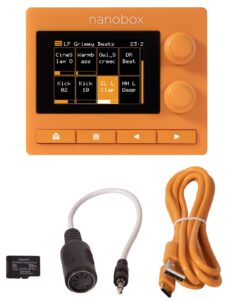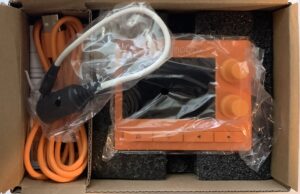This is the droid I’m looking for. 🙂
1010Music have released a line of colorful nanoboxes: razzmatazz drum sequencer (pink), fireball polyphonic wavetable synth (red), lemondrop polyphonic granular midi synth (yellow) and tangerine compact streaming sampler. All of the nanoboxes share the same 1.5″ x 3.75″ x 3″ form factor, have a touch display, two encoders and four buttons. They sip power through the USB-C port.
Even though the industrial design looks “Fisher Price”, the build is robust. The plastic case is sturdy, the encoders have a fair bit of resistance and the buttons feel solid. I would worry a lit bit about dinging up the display in a gig bag, so a little love and care is advised. 1010Music have a battery case on the way to enclose and power a nanobox. ($69 USD)
The 1010Music tangerine is the latest and I found its spec irresistible. The tangerine is a stereo sampler supporting both sequencing and multi-sampling. Functionally, the tangerine is like Samplerobot in a tiny box! When connected to an external synth, module, whatever, it will capture a range of notes and will do so at different velocity levels (max 16 levels). Poly is 24 stereo notes when samples fit into the 64 MByte internal memory; poly is eight when streaming large samples from a microSD card.
I’ve been waiting a long time for a portable multi-sample recording and playback engine like this. I intend to use tangerine as a portable MIDI module to augment other tools like Yamaha Reface or Arturia Keylab Essential. tangerine plus a small ‘board will give me a compact, ultra-light gig rig. I might be able to play under full battery power!
I will definitely exploit tangerine’s multi-sampling capability to capture sounds from my Yamaha CSP-170 digital piano and the Arturia Augumented 6 instruments collection. I recently purchased the Augmented collection as a way of evaluating the sounds in Arturia AstroLab. If I capture my favorite woodwind patches, etc., I may forego AstroLab, which is a bit heavy for my blown-out body.
I spent quality time with tangerine yesterday and feel like my enthusiasm (and plans) are justified. 1010Music have written an excellent user manual which helped me dive in. The tangerine menus are easy to navigate and there are navigation shortcuts (e.g., hold the HOME button and enter the Teleporter screen to jump directly to a screen).
Mainly, I explored the factory content which includes big and small acoustic pianos, drum and percussion kits, loops and clips, and a smattering of multi-sampled instrument sounds. I suggest reading and learning about the sample types and how pads, samples, presets, files, etc. are organized. If you’re familiar with typical sampling and synth concepts (loop parameters, envelopes, filters, effects), everything else will drop into place intuitively.
If you dive right into the presets, please be aware that clip samples need to have a running sequencer clock to play back. Else, you’ll wonder, “Why isn’t that clip playing?” Touch the “measure:beat” in the upper right corner of the display to go to Transport screen. You’ll find the START and STOP buttons there.
tangerine’s $400 USD selling price might give you pause when considering a purchase. Even with the tangerine in hand, I questioned dropping $400. However, this box is deep. Sure, there are some fancy-Dan features which you may not find. (For me, no way to change sampling rate.) Rest assured, 1010Music have invested a lot of engineering and software development time. Engineers need to eat and sleep indoors, too. 🙂 I suspect there is a lot of commonality and code reuse across the nanobox product line, so hopefully, that will help 1010Music roll out new upgrades at a faster pace.
Bottom line, I’m looking forward to good times ahead!
Copyright © 2024 Paul J. Drongowski


